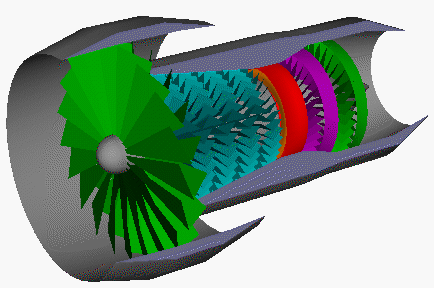
|
This page is intended for college, high school, or middle school students.
For younger students, a simpler explanation of the information on this page is
available on the
Kids Page.
|

|
Turbofan
Engine
|
Glenn
Research
Center
|








To move an
airplane
through the air,
thrust
is generated by some kind of
propulsion system.
Most modern airliners use
turbofan engines because of their high thrust and good
fuel efficiency.
On this page, we will discuss
some of the fundamentals of turbofan engines.
A turbofan engine is the most modern variation of the basic
gas turbine
engine. As with other gas
turbines, there is a
core engine,
whose
parts
and operation are discussed on a
separate page. In the turbofan engine, the core engine is surrounded
by a fan in the front and an additional turbine at the rear. The fan
and fan turbine are composed of many blades, like the core
compressor
and core
turbine,
and are connected to an additional shaft. All of
this additional turbomachinery is colored green on the
schematic.
As with the core compressor
and turbine, some of the fan blades turn with the shaft and some
blades remain stationary. The fan shaft passes through the core shaft
for mechanical reasons. This type of arrangement is called a two
spool engine (one "spool" for the fan, one "spool" for the core.)
Some advanced engines have additional spools for even higher
efficiency.
How does a turbofan engine work? The incoming air is captured by
the engine
inlet.
Some of the incoming air passes
through the fan and continues on into the core compressor and then the
burner,
where it is mixed with fuel and
combustion
occurs. The hot exhaust passes through the core and fan turbines and
then out the
nozzle,
as in a basic
turbojet.
The rest of the incoming air passes through the fan
and bypasses, or goes around the engine, just like the air
through a
propeller.
The air that goes
through the fan has a velocity that is slightly increased from free
stream. So a turbofan gets some of its thrust from the core and some
of its thrust from the fan. The ratio of the air that goes around the
engine to the air that goes through the core is called the bypass
ratio.
Because the fuel flow rate for the core is changed only a small
amount by the addition of the fan, a turbofan generates more thrust
for nearly the same amount of fuel used by the core. This means that
a turbofan is very fuel efficient. In fact, high bypass ratio
turbofans are nearly as fuel efficient as
turboprops.
Because the fan is enclosed by the inlet and is composed of many
blades, it can operate efficiently at higher speeds than a simple
propeller. That is why turbofans are found on high speed transports
and propellers are used on low speed transports. Low bypass ratio
turbofans are still more fuel efficient than basic turbojets. Many
modern fighter planes actually use low bypass ratio turbofans
equipped with
afterburners.
They can then
cruise efficiently but still have high thrust when dogfighting. Even
though the fighter plane can fly much faster than the speed of sound,
the air going into the engine must travel less than the speed of
sound for high efficiency. Therefore, the airplane inlet slows the
air down from supersonic speeds.
The
mathematics
describing the
thrust of a turbofan engine
is given on a separate slide.
Activities:


Guided Tours
Navigation ..

- Beginner's Guide Home Page
|
